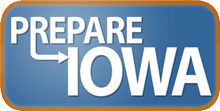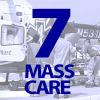


Capability 7: Mass Care
Definition: Mass care is the ability to coordinate with partner agencies to address the public health, medical, and mental/behavioral health needs of those impacted by an incident at a congregate location. This capability includes the coordination of ongoing surveillance and assessment to ensure that health needs continue to be met as the incident evolves.
Functions and Associated Performance Measures: This capability consists of the ability to perform the functions listed below. At present there are no CDC-defined performance measures for these functions.
Function 1: Determine public health role in mass care operations
Function 2: Determine mass care needs of the impacted population
Function 3: Coordinate public health, medical, and mental/behavioral health services
Function 4: Monitor mass care population health
Mass Triage Interactive Training: A Short Course [1]
This train-the-trainer toolkit, from the Tarrant County Advanced Practice Center, provides refresher and just-in-time training in triage methods for public health and healthcare providers responding to mass casualty incidents involving hazardous agents. It is based on the National Disaster Life Support Foundation (NDLSF) Decon training: a two-day training course offered by the NDLSF National Training Center at UT Southwestern Medical Center in Dallas, TX. The CD also provides a training overview for educators on two other triage methods, SACCO and START.
IS-806: Emergency Support Function (ESF) #6 - Mass Care, Emergency Assistance, Housing, and Human Services [2]
The National Response Framework (NRF) presents the guiding principles that enable all response partners to prepare for and provide a unified national response to disasters and emergencies – from the smallest incident to the largest catastrophe. As part of the NRF, Emergency Support Functions (ESFs) are primary mechanisms at the operational level used to organize and provide assistance. This series of courses provides an overview of each of the 14 ESFs. This course introduces Emergency Support Function (ESF) #6 – Mass Care, Emergency Assistance, Housing, and Human Services. This course is part of FEMA's Emergency Management Institute Independent Study Program.
Mass Casualty Incident Triage [3]
This course from the South Central Public Health Partnership is intended for pre-hospital care providers and firefighters who may be called on to respond to a mass casualty incident resulting when a large numbers of victims are injured or exposed to hazardous materials or WMD agents. The course will prepare trainees to use the Simple Triage and Rapid Treatment (START) system, Incident Management System (IMS) and the FEMA Job-Aid in order to respond with maximum effectiveness to a mass casualty event. Previous training of trainees may range from Firefighter/ First Responder and/or EMT-Basic to Paramedic.
Mass Gatherings: Are You Prepared? [4]
Food poisoning at the fair, rabies exposure at the rodeo, crowd trampling at a World Cup game: what is the role of public health at events that attract large crowds? This module will teach you to assess and plan for the prevention and mitigation of public health threats at mass gatherings. It covers topics of risk assessment, surveillance, health response, coordination, and communication. This 90-minute module can be completed over several shorter sessions. It also includes a unique practice scenario to further enhance your learning. This course is co-sponsored by the Northwest Center for Public Health Practice and the University of Washington College of Nursing.
Medical Mass Care During an Influenza Pandemic: Guide & Toolkit for Establishing Care Centers [5]
This toolkit from the County of Santa Clara Advanced Practice Center serves as a resource for local public health departments to develop plans for medical mass care. The toolkit provides scalable, operational direction and tools for the establishment of alternative care sites, i.e. Influenza Care Centers (ICC) to meet the health care needs of patients requiring hospital care who are not able to receive such care at one of the local hospitals. Although the guide focuses on pandemic influenza, the approaches described and the tools provided can be adapted for other medical-health emergencies and hazards requiring medical mass care.
Public Health Emergency Exercise Toolkit [6]
This toolkit, from the Columbia University School of Nursing, is intended to guide local public health agency staff in (1) developing, implementing, and evaluating emergency drills and exercises, and (2) facilitating the public health aspects of larger, multiagency emergency exercise events. The toolkit provides essential guidance including templates, checklists, and forms to assist with every stage of the exercise process. Emphasis is on identification of objectives during the planning phase, a critical step for ensuring a meaningful postexercise evaluation. The information in this document is consistent with the approaches recommended by the U.S. Department of Homeland Security’s (DHS) Office of Domestic Preparedness (ODP) and the Homeland Security Exercise and Evaluation Program (HSEEP).
Designing, Implementing, and Evaluating a Public Health Exercise—A Dirty Bomb Disaster [7]
This interactive training course from the Tarrant County Advanced Practice Center assists public health and emergency management professionals in designing and conducting a full-scale disaster exercise. Video footage details Tarrant County's full-scale dirty bomb disaster drill, which was conducted in Texas during November 2004. This tool also includes an interactive training manual and a lecture series focused on the design and evaluation components of a public health exercise.
Links
[1] http://apc.naccho.org/Products/APC20081485/Pages/Overview.aspx
[2] http://www.training.fema.gov/EMIWeb/IS/courseOverview.aspx?code=IS-806
[3] https://cdc.train.org/DesktopModules/eLearning/CourseDetails/CourseDetailsForm.aspx?tabid=62&courseid=1012716&backURL=L0Rlc2t0b3BTaGVsbC5hc3B4P3RhYmlkPTYyJmdvdG89YnJvd3NlJmJyb3dzZT1jb21wZXRlbmN5JmtleXdvcmQ9bWFzcytBTkQrY2FyZSZrZXlvcHRpb249Qm90aCZjbGluaWNhbD1ib3RoJmxvY2FsPWFsbCZCeUNvc3Q9MQ==
[4] https://cdc.train.org/DesktopModules/eLearning/CourseDetails/CourseDetailsForm.aspx?tabid=62&courseid=1025099&backURL=L0Rlc2t0b3BTaGVsbC5hc3B4P3RhYmlkPTYyJmdvdG89YnJvd3NlJmJyb3dzZT1jb21wZXRlbmN5Jmxvb2tmb3I9bm9kZXM6MzMsMzQsMzUsMzYmY2xpbmljYWw9Ym90aCZsb2NhbD1hbGwmQnlDb3N0PTE=
[5] http://apc.naccho.org/Products/APC20071550/Lists/Product%20Documents/Medical_Mass_Care_During_an_Influenza_Pandemic_Guide_and_Toolkit_for_Establishing_Care_Centers.pdf
[6] http://nursing.columbia.edu/pdf/PublicHealthBooklet_060803.pdf
[7] http://apc.naccho.org/Products/APC2005272/Pages/Overview.aspx